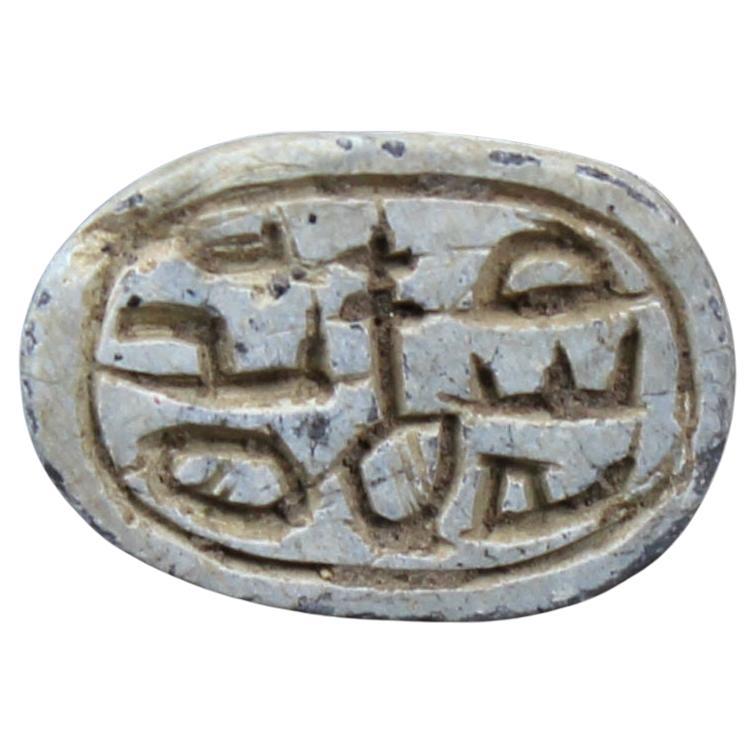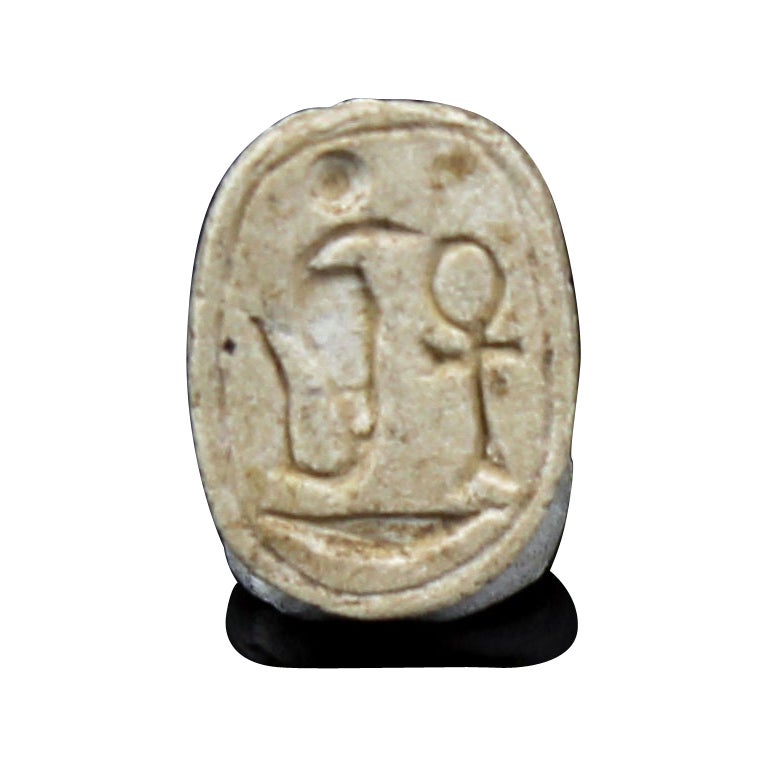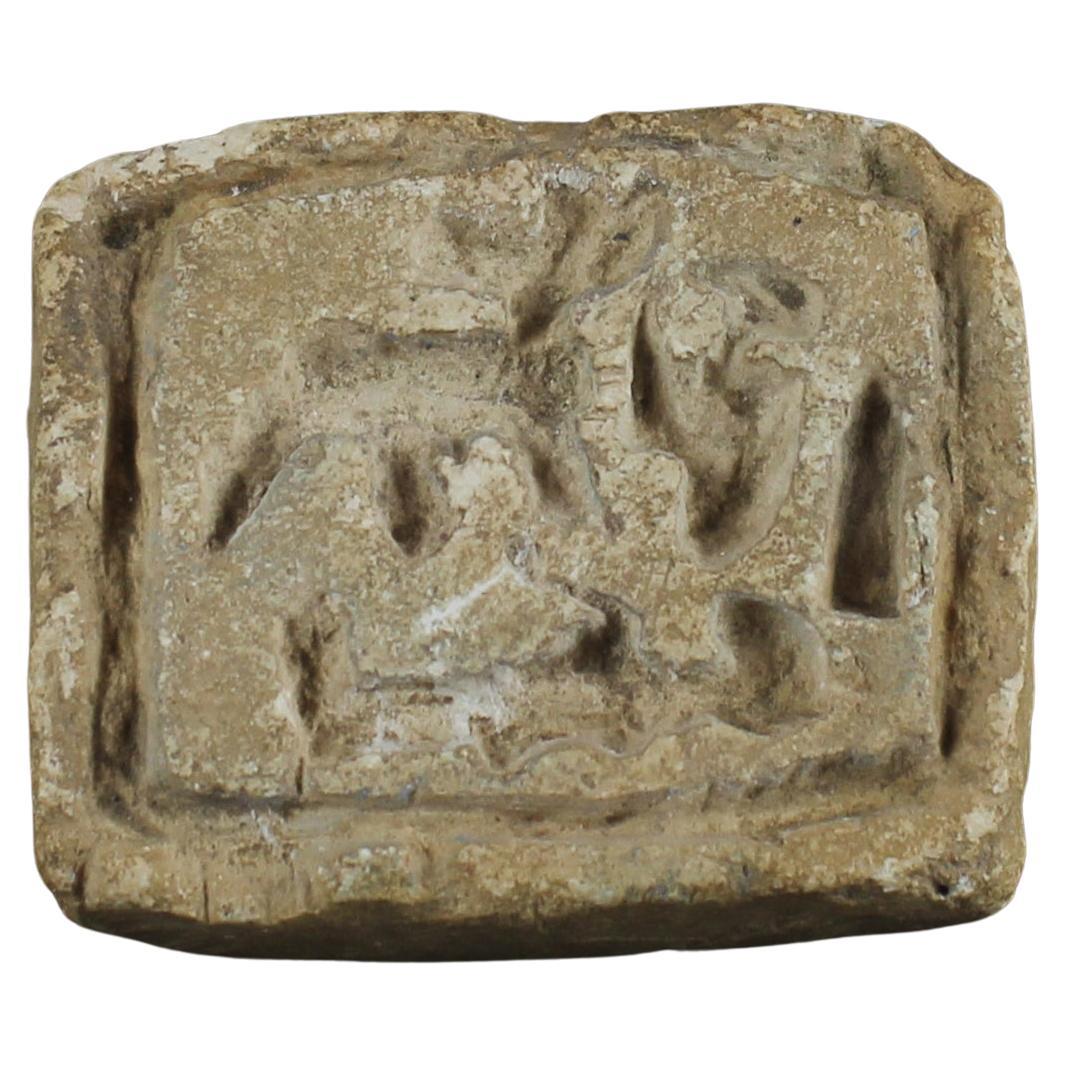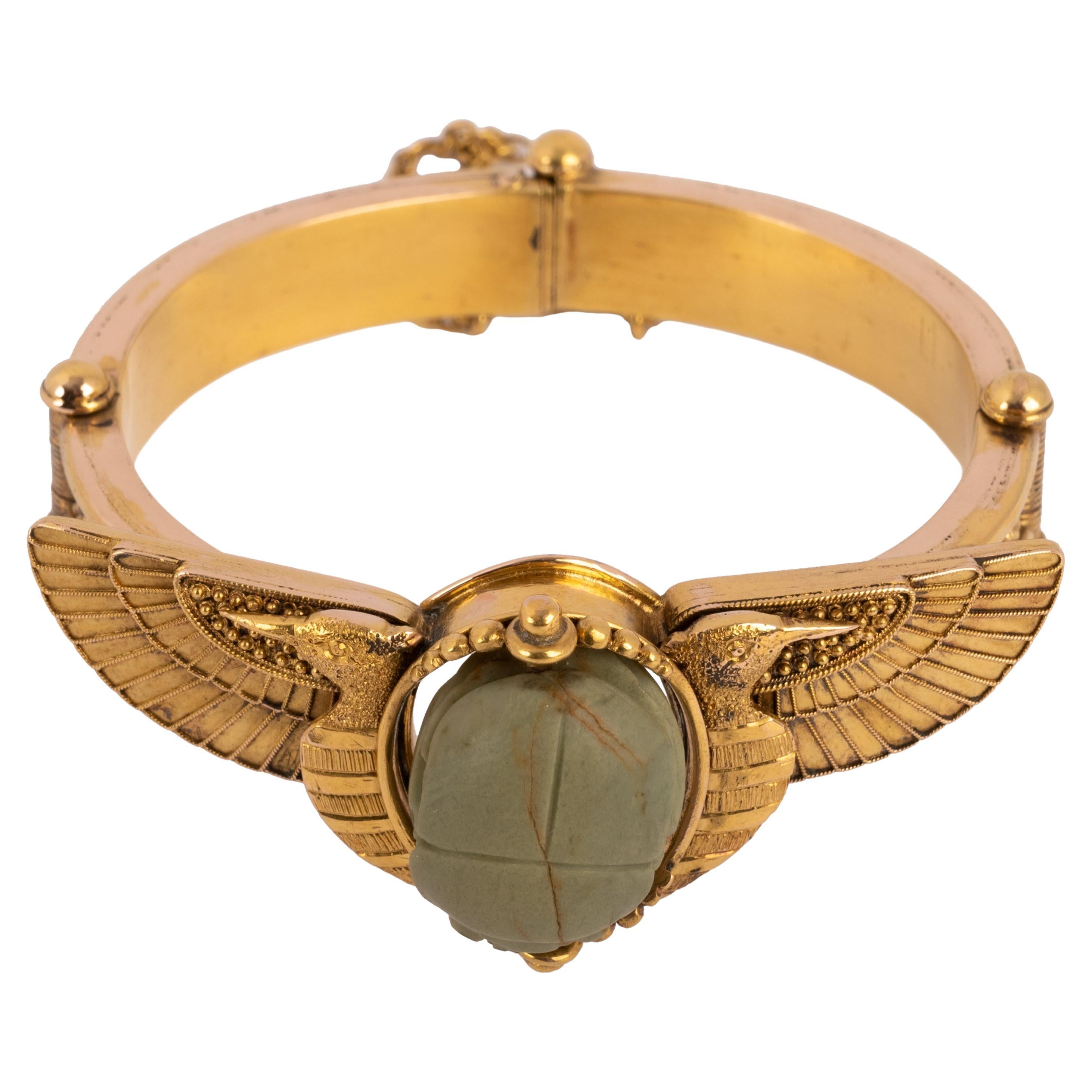Items Similar to Egyptian scarab with spiral design
Want more images or videos?
Request additional images or videos from the seller
1 of 6
Egyptian scarab with spiral design
About the Item
ITEM: Scarab with spiral design
MATERIAL: Steatite
CULTURE: Egyptian
PERIOD: Second Intermediate Period, 1700 – 1550 B.C
DIMENSIONS: 12 mm x 9 mm
CONDITION: Good condition
PROVENANCE: Ex American egyptologist collection, active in the early part of the 20th century, brought to the US with the family in 1954.
Comes with Certificate of Authenticity and Export Licence. If you are from outside the European Union, we will have to apply for the export licence again for your country, this takes 4 to 6 weeks.
During the Second Intermediate Period of ancient Egypt (circa 1650–1550 BCE), scarabs carved from steatite emerged as significant artifacts reflecting the cultural, religious, and political landscape of the time. Steatite, also known as soapstone, was a commonly used material for crafting scarabs due to its softness, making it easier to carve intricate designs and inscriptions. These scarabs played various roles, serving as amulets, seals, and commemorative items, while also providing valuable insights into the beliefs and practices of ancient Egyptians during this tumultuous period.
Scarabs from the Second Intermediate Period often depicted traditional motifs such as the scarab beetle itself, symbolic of rebirth and regeneration, as well as other religious symbols like the ankh (symbol of life) and the djed pillar (symbol of stability and resurrection). Inscriptions on these scarabs frequently included the names and titles of rulers, officials, or deities, along with prayers, blessings, or magical spells intended to invoke divine protection or favor. These inscriptions not only served practical purposes, such as sealing documents or containers, but also conveyed important religious and political messages.
The Second Intermediate Period was marked by political instability and foreign invasions, particularly by the Hyksos, a group of Asiatic people who established their rule in the Nile Delta region. Scarabs from this period reflect the complex interactions between native Egyptian traditions and the cultural influences of foreign rulers. Some scarabs may bear inscriptions or iconography associated with Hyksos kings, while others may feature traditional Egyptian motifs alongside symbols of foreign origin.
- Dimensions:Height: 0.48 in (1.2 cm)Width: 0.36 in (9 mm)Depth: 0.01 in (0.1 mm)
- Style:Egyptian (Of the Period)
- Materials and Techniques:
- Place of Origin:
- Period:
- Date of Manufacture:Second Intermediate Period, 1700 – 1550 B.C
- Condition:
- Seller Location:EL CAMPELLO, ES
- Reference Number:1stDibs: LU7382238735842
About the Seller
5.0
Vetted Seller
These experienced sellers undergo a comprehensive evaluation by our team of in-house experts.
Established in 2011
1stDibs seller since 2022
8 sales on 1stDibs
- ShippingRetrieving quote...Ships From: El Campello, Spain
- Return PolicyA return for this item may be initiated within 60 days of delivery.
More From This SellerView All
- Egyptian scarab with pseudo-hieroglyphic, Anra-typeLocated in EL CAMPELLO, ESITEM: Scarab with pseudo-hieroglyphic, Anra-type MATERIAL: Steatite CULTURE: Egyptian PERIOD: Second Intermediate Period, 1700 – 1550 B.C DIMENSIONS: 10 mm x 15 mm CONDITION: Good co...Category
Antique 15th Century and Earlier Egyptian Egyptian Antiquities
MaterialsStone
- Egyptian scarab with Uraeus, Ankh and neb basket (Amun trigram)Located in EL CAMPELLO, ESITEM: Scarab with Uraeus, Ankh and neb basket (Amun trigram) MATERIAL: Steatite CULTURE: Egyptian PERIOD: New Kingdom, 1550 – 1070 B.C DIMENSIONS: 12 mm x 8 mm CONDITION: Good condit...Category
Antique 15th Century and Earlier Egyptian Egyptian Antiquities
MaterialsStone
- Egyptian scarab as a commemorative of Ramesses II or prenomen of Shoshenq IIILocated in EL CAMPELLO, ESITEM: Scarab as a commemorative of Ramesses II or prenomen of Shoshenq III MATERIAL: Black steatite CULTURE: Egyptian PERIOD: New Kingdom to Third Intermediate Period, 1279 – 664 B.C...Category
Antique 15th Century and Earlier Egyptian Egyptian Antiquities
MaterialsStone
- Scarab with prenomen for Amenhotep IILocated in EL CAMPELLO, ESITEM: Scarab with prenomen for Amenhotep II MATERIAL: Steatite CULTURE: Egyptian PERIOD: New Kingdom, XVIIIth Dynasty, 1143 – 1417 B.C DIMENSIONS: 15 mm x 11 mm CONDITION: Good condi...Category
Antique 15th Century and Earlier Egyptian Egyptian Antiquities
MaterialsStone
- Egyptian seal with Ptah, Anubis and vultureLocated in EL CAMPELLO, ESITEM: Seal with Ptah, Anubis and vulture MATERIAL: Stone CULTURE: Egyptian PERIOD: Middle Kingdom, 2040 – 1782 B.C DIMENSIONS: 39 mm x 45 mm x 32 mm CONDITION: Good condition PROVENA...Category
Antique 15th Century and Earlier Egyptian Egyptian Antiquities
MaterialsStone
- Romano-Egyptian cartonnage mummy mask depicting a female headLocated in EL CAMPELLO, ESITEM: Romano-Egyptian cartonnage mummy mask depicting a female head MATERIAL: Linen and Gesso CULTURE: Egyptian, Roman period PERIOD: 1st Century B.C – 1st Century A.D DIMENSIONS: 20...Category
Antique 15th Century and Earlier Egyptian Classical Roman Antiquities
MaterialsGesso, Linen
You May Also Like
- Antique 22 Karat Gold Egyptian Etruscan Revival Scarab Beetle Bracelet 1870Located in Portland, ORA rare antique Egyptian Revival 22 karat gold bracelet, circa 1870. Gold weight 38.10 grams. This continental gold bracelet tests as 22 karat gold and is fitted with a green faience ancient Egyptian scarab, engraved with Hieroglyphics. The front of the bracelet is modelled as a twin headed winged ibis amulet and is fitted to the center with a faience scarab, which swivels to show the Hieroglyphics. The bracelet band having Etruscan style beaded granulated decoration and a strong closing clasp and opening chain. Condition is excellent. The bracelet was last purchased in 1968 from the prestigious London antique jewelery dealers; Anne Bloom located at 124 New Bond Street London for 1500 (Great British Pounds...Category
Antique 1870s French Egyptian Revival Antiquities
MaterialsGold
- Egyptian Copper Plate with Silver Inlay Hieroglyphics, Early 19th CenturyLocated in Islamabad, PKThe large-scale copper charger plate with silver inlay is a truly awe-inspiring work of art. Its grand size and intricate design make it a captivating piece that commands attention a...Category
Antique 19th Century Egyptian Egyptian Antiquities
MaterialsSilver, Copper
- Set of Four Egyptian Antiquities, Pair of Sarcophagus Faience & Two FigurinesLocated in New York, NYThis captivating authentic Egyptian Faience set was realized in ancient Egypt circa 3100 BCE. It offers two sarcophagus figurines- suggestive of miniature versions of King Tut's tomb- hand finished in a beautiful turquoise hue (a glaze created by pulverizing the stone into pigment). Additionally, the set features two figurines (one representative of the Egyptian god Anubis), and the other seemingly a depiction of one of the ruler's as a young child also in a turquoise glaze atop volumetric rhombus plinths with tapered sides in a refined terra cotta hue. Full of historical importance (and stunning as stand alone objects) this collection of Egyptian antiquities...Category
Antique 15th Century and Earlier Egyptian Egyptian Figurative Sculptures
MaterialsFaience
- Pair of Bronze Age Spiral PendantsLocated in Vosselaar, BEPair of Spiral pendants, bronze age, Europe, circa 1000 BC, 3 and 3 half inches 7 9 cm, mounted on custom stands. Provenance: From a private European collection; formed in the 1980s.Category
Antique 15th Century and Earlier European Antiquities
MaterialsBronze
- Yellow Kyouyaki Incense Burner with Silver Lid with Lotus Design, Taisho PeriodLocated in Chuo-ku, TokyoMonochrome porcelain fired in Kyoto The shape is modeled after an ancient Chinese incense burner. It has a simple shape with eight strings and...Category
Antique 19th Century Japanese Taisho Antiquities
MaterialsSilver, Enamel
- Imari Porcelain With Hand-Painted Landscape design, Edo PeriodLocated in Chuo-ku, TokyoImari ware made in the Arita area during the Edo period. Gourd-shaped with a slender neck and mouth, it has a graceful appearance. The style is reminiscent of Chinese Ming Dynasty paintings...Category
Antique 18th Century Japanese Edo Antiquities
MaterialsPorcelain
Recently Viewed
View AllMore Ways To Browse
Long 36 60 Inches Wall Mirror
Asian Art Deco Furniture
Wood And Metal Lamp
Glasses Set Of 12
Mid Century Table With Crafted Top
Asian Asian Screen
Art Deco Office Items
People In Garden
Midcentury Swedish Carpet
Table With Ormolu
Glass Metal Wall Art
Leather Tooling
Vase Vessel Orange
Line Pendant
Wall Mount Mirror
Wood Case Chair
Mid Century Office Chairs Set
Wooden Chair With Upholstery





